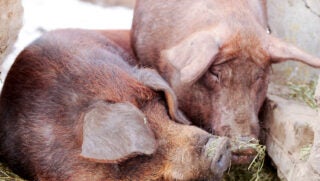Travis Hoffman wants your next celebratory meal to be bold, sophisticated, and memorable for all the right reasons. He wants it to include American lamb, and he’s working to make lamb delectable.
“Lamb provides a unique and bold eating experience different than ground beef tacos or pork chops,” Hoffman said. “Lamb provides versatility for a menu or a new flavor for people to consume at home with their families.”
A restaurateur reminded Hoffman that protein producers are providing consumers with an opportunity to celebrate. “In the red meat protein business, we are providing life experiences,” he said. “People go to restaurants or steak houses to celebrate life and no matter what the protein of choice is, it’s our job to ensure quality. Research has shown that eating the experience, particularly flavor and tenderness, of meat proteins is the reason people choose to consume products in their celebrations.”
Even though beef is still the center of the plate and pork is the ingredient meat of choice, lamb provides a red meat alternative to those who consider themselves more adventurous eaters and wish to experience a different flavor profile, adding variety and worldliness to their palate. Despite a lack of growth in the consumption of lamb in recent years, the demand for lamb is likely to grow as consumers seek unique dishes in their quest to make meal time memorable.
Hoffman anticipates that a red meat protein as trendy and sophisticated as lamb will be marketed in an equally innovative and unique way.“Within the next five to eight years, we will be at a point where we will be able to sort lamb carcasses and cuts based on flavor and based on production management,” he said. “What some envision is marketing of lamb much like coffee. If we provide a mild, medium and bold flavor profile based upon short-chain fatty acids and the composition of the meat determined by production management, we could then fit the palate preferences of our consumers.”
In recent years, lamb consumption in the U.S. has been relatively stagnant. With more people touting themselves as foodies and wishing to experiment in their menu choices, lamb has the opportunity to take a strong hold and capture market opportunity for those Hoffman describes as having “an exquisite and interesting palate preference.” Currently, lamb consumption is hovering at one pound of lamb per person per year. These opportunities could spell growth on the horizon for the industry.
However, before all of this can come to fruition, Hoffman has to define lamb flavor, determine production management costs, and market and identify carcasses of value and what will change to a value-based marketing of lamb.
This is where the stars align for Hoffman and the American lamb producers. Hoffman is now leading extension and outreach efforts to sheep producers through a joint appointment between North Dakota State University and the University of Minnesota. The position, composed of part extension and part research, will allow him to continue a few important goals to improve the lamb business for all involved.
As the lamb industry is currently built, too often marketed wethers, ewes, or rams are sold on a commodity-based system. This means that lambs are sold on a dollars per hundred weight basis with the only driver of value being pounds.
“Within the next five to 10 years, I envision greater emphasis on meeting a more defined parameter of lamb quality and thus rewarding producers who raise lambs that are compositionally correct and provide a muscular, trim lamb product.”
The difference compared to the beef industry is that quality grades of beef are a driver and indicator of expected palatability. The difference in lamb quality grade is that most lambs will grade USDA Choice with a smaller subset that will go USDA Prime. Truthfully, Hoffman explains, lambs that are USDA Choice or better are sold at the same value.
There is a much larger difference in marketing lamb based on yield grade.
“One of the projects I’ll be working on is determining the cost of fat in the U.S. lamb supply chain,” he said. “With increases of external and seam fat, we lose value along the chain so trimmer lambs and lambs that are fed to a compositionally correct endpoint allow feeders to better optimize growth as it relates to finish of lambs.”
The sheep industry has historically been challenged on seasonality of production because most lambs are born in the spring and are ready for market at a similar point throughout the year. Producers need to manage and mitigate losses in efficiency in feeding overfat lambs, losses in efficiency in fabrication that requires greater external fat removal on a fabrication floor and wish to decrease lamb products at the retail setting that are too fat.
The fat, as protein loving foodies know, is where the flavor is derived in most meats. Consequently, lambs have differences in short chain fatty acids. Hoffman’s research is looking at fatty acid profile and composition of lamb and indicators of flavor so producers can be able to meet expectations related to lamb flavor.
According to Hoffman, the lamb industry can always market some small or young lambs to ethnic or non-traditional markets. They can always market large lambs, specifically the rack, to hotels or higher end restaurants that want a defined serving size with rack or loin chops. If producers can keep animals and carcasses in a reasonable weight range, it allows lamb processors more flexibility in where lambs can be marketed and not market a product that is excessively fat.
Hoffman’s PhD research on the 2015 National Lamb Quality Audit determined that lamb flavor is the reason people purchase lamb. However, lamb flavor is also the reason people don’t purchase lamb.
“I believe that lamb is a trendy upscale protein being featured on more food service and restaurant menus primarily because there is a group of Millennials who want to experience new foods and align eating experiences with their personal culture and lifestyle,” Hoffman said. “Those who will one day consider themselves affluent wish to try new things.”

Originally from Rockham, South Dakota, Hoffman earned a Bachelor of Science from South Dakota State University in 2003 in Animal Science. He earned his master’s degree at Colorado State University in 2008 in Meat Sciences during which time he also served as the Colorado Meat Quality Assurance Coordinator for over eight years. He completed a PhD program at Colorado State University in December of 2015 with an emphasis on the National Lamb Quality Audit and defining lamb quality across the supply chain.
He was one of three finalists of the South Dakota State University College of Agriculture and Biological Sciences Teacher of the Year this year and began his new assignment this summer.



